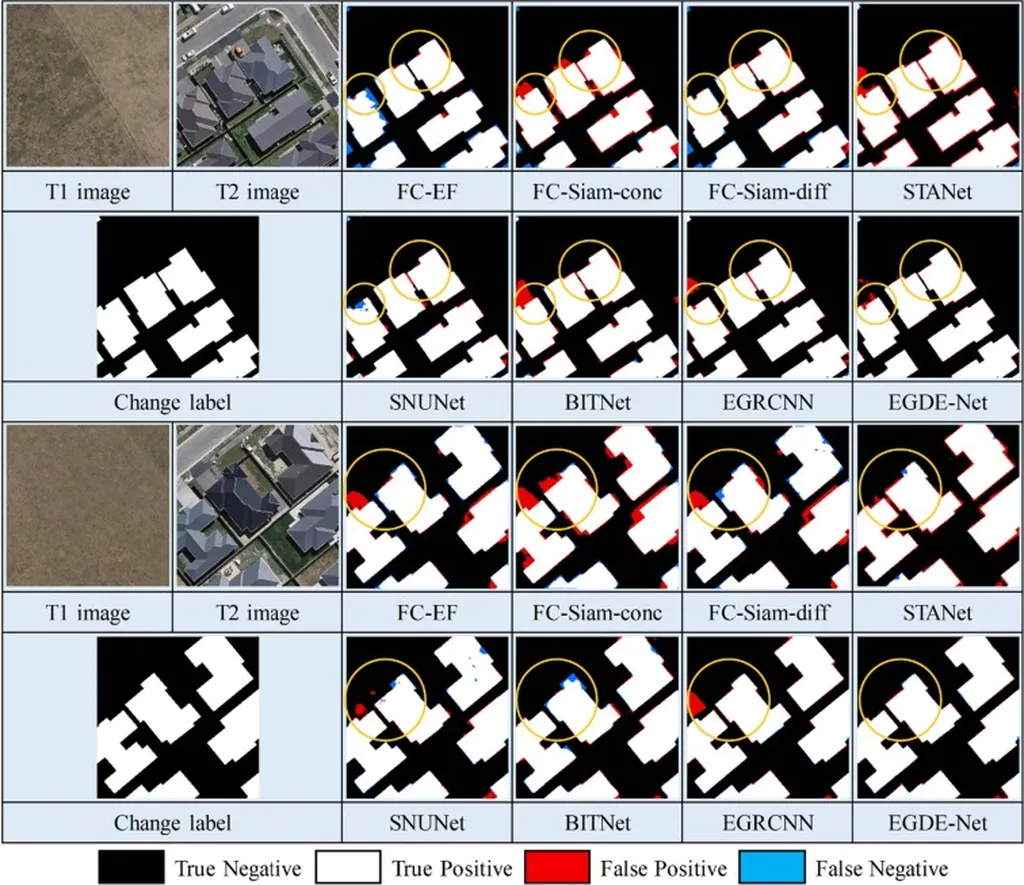In the rapidly evolving world of remote sensing technology, a groundbreaking development has emerged that promises to revolutionize how we monitor and analyze changes in our built environment. Researchers have introduced DFANet, a Deep Feature Attention Network designed specifically for building change detection in remote sensing imagery. This innovation, led by Peigeng Lu from the School of Remote Sensing and Geomatics Engineering at Nanjing University of Information Science and Technology, addresses critical limitations in current change detection methods, offering significant advancements for various industries, including the energy sector.
Change detection (CD) in remote sensing is a fundamental task that involves identifying changes in land cover by analyzing images taken at different times. Traditional methods have struggled with detecting building edges accurately and reducing pseudo-changes—false detections that can lead to misleading conclusions. DFANet tackles these challenges head-on by incorporating several novel components. “Our spatial-channel attention module enhances the network’s ability to extract change cues from bitemporal feature maps, significantly reducing pseudo-changes,” explains Lu. This improvement is crucial for applications that require precise and reliable data, such as urban planning and infrastructure development.
One of the standout features of DFANet is the GatedConv module, which improves the network’s capability for building edge detection. This is particularly important for the energy sector, where accurate mapping of urban expansions and infrastructure changes can inform decisions about energy distribution and grid management. “The GatedConv module allows us to capture fine details and edges, which are often overlooked by traditional methods,” Lu adds. This level of detail is essential for energy companies looking to optimize their operations and plan for future growth.
Moreover, DFANet introduces a Transformer to capture long-range dependencies across bitemporal images. This enables the network to better understand feature change patterns and the relationships between different regions and land cover categories. “By leveraging the Transformer, we can model the context of changes over large areas, providing a more comprehensive and accurate analysis,” Lu notes. This capability is invaluable for energy sector applications, where understanding the broader context of land use changes can help in strategic planning and resource allocation.
The research team conducted comprehensive experiments on two publicly available building CD datasets—LEVIR-CD and WHU-CD. The results demonstrated that DFANet achieves exceptional performance in evaluation metrics such as precision, F1 score, and IoU, consistently outperforming existing state-of-the-art approaches. These findings were published in the journal *Remote Sensing*, known in English as *Remote Sensing*, underscoring the significance of this work in the field.
The implications of DFANet extend beyond the energy sector. Urban planners, environmental scientists, and disaster management teams can all benefit from more accurate and reliable change detection methods. As cities continue to grow and infrastructure evolves, the ability to monitor and analyze these changes in real-time becomes increasingly important. DFANet represents a significant step forward in this direction, offering a powerful tool for a wide range of applications.
Looking ahead, the success of DFANet opens up new avenues for research and development in remote sensing technology. Future advancements could focus on integrating additional data sources, such as LiDAR and hyperspectral imagery, to further enhance the accuracy and reliability of change detection methods. Additionally, the incorporation of machine learning techniques could enable real-time analysis and predictive modeling, providing even greater insights into urban and environmental changes.
In conclusion, DFANet’s innovative approach to building change detection sets a new standard in the field of remote sensing. By addressing critical limitations and introducing novel components, this research paves the way for more accurate and reliable analysis of land cover changes. As the energy sector and other industries continue to evolve, the insights provided by DFANet will be invaluable in shaping future developments and ensuring sustainable growth.

